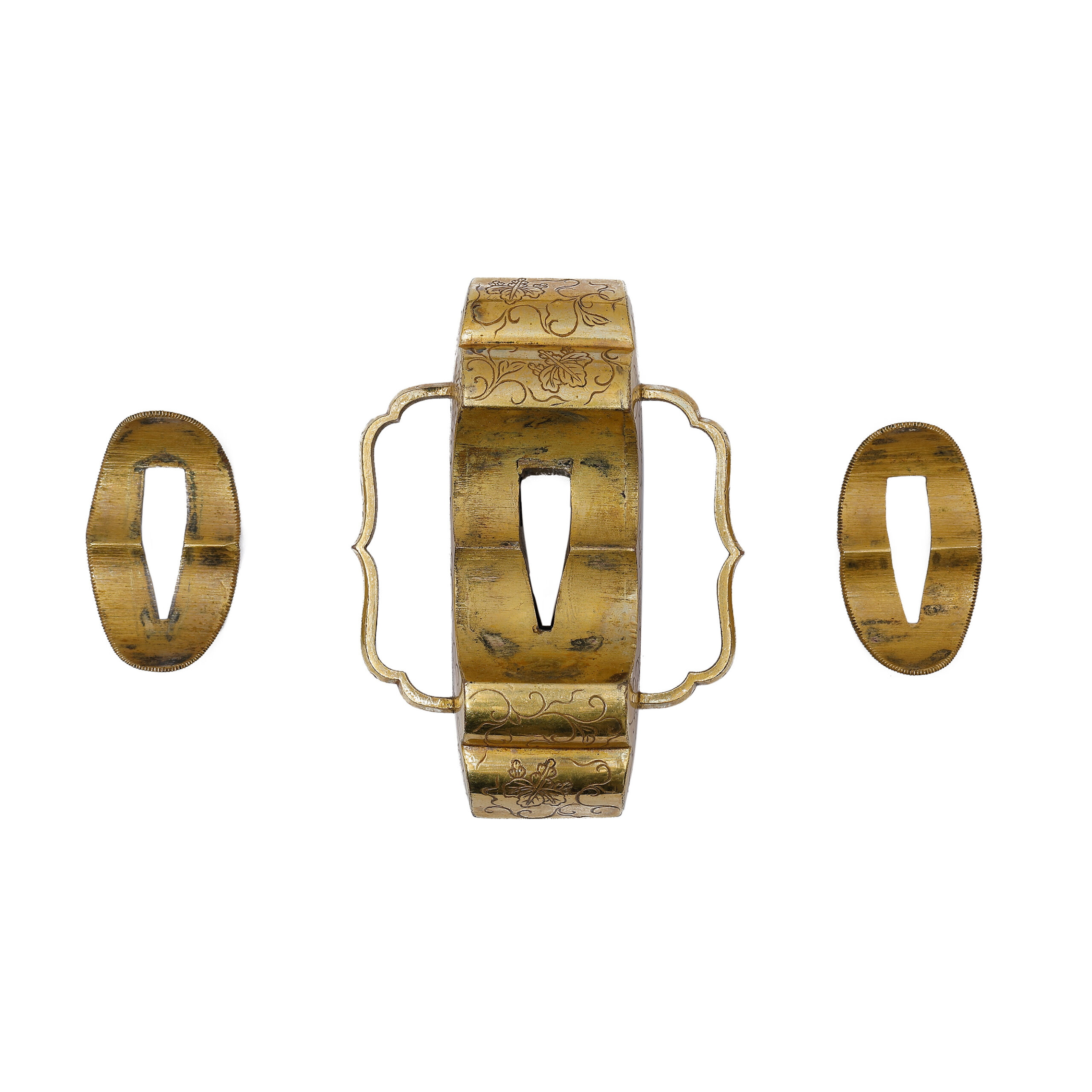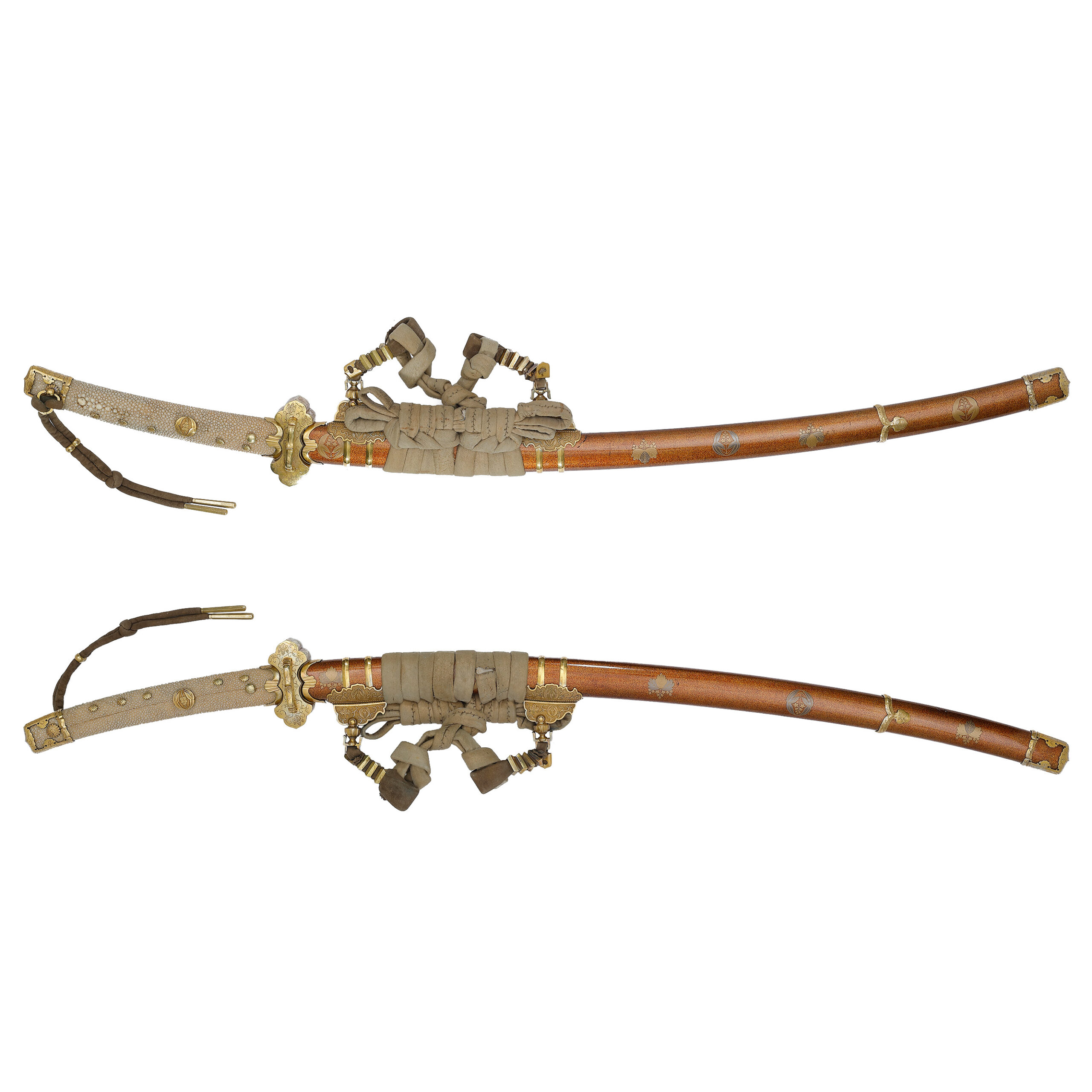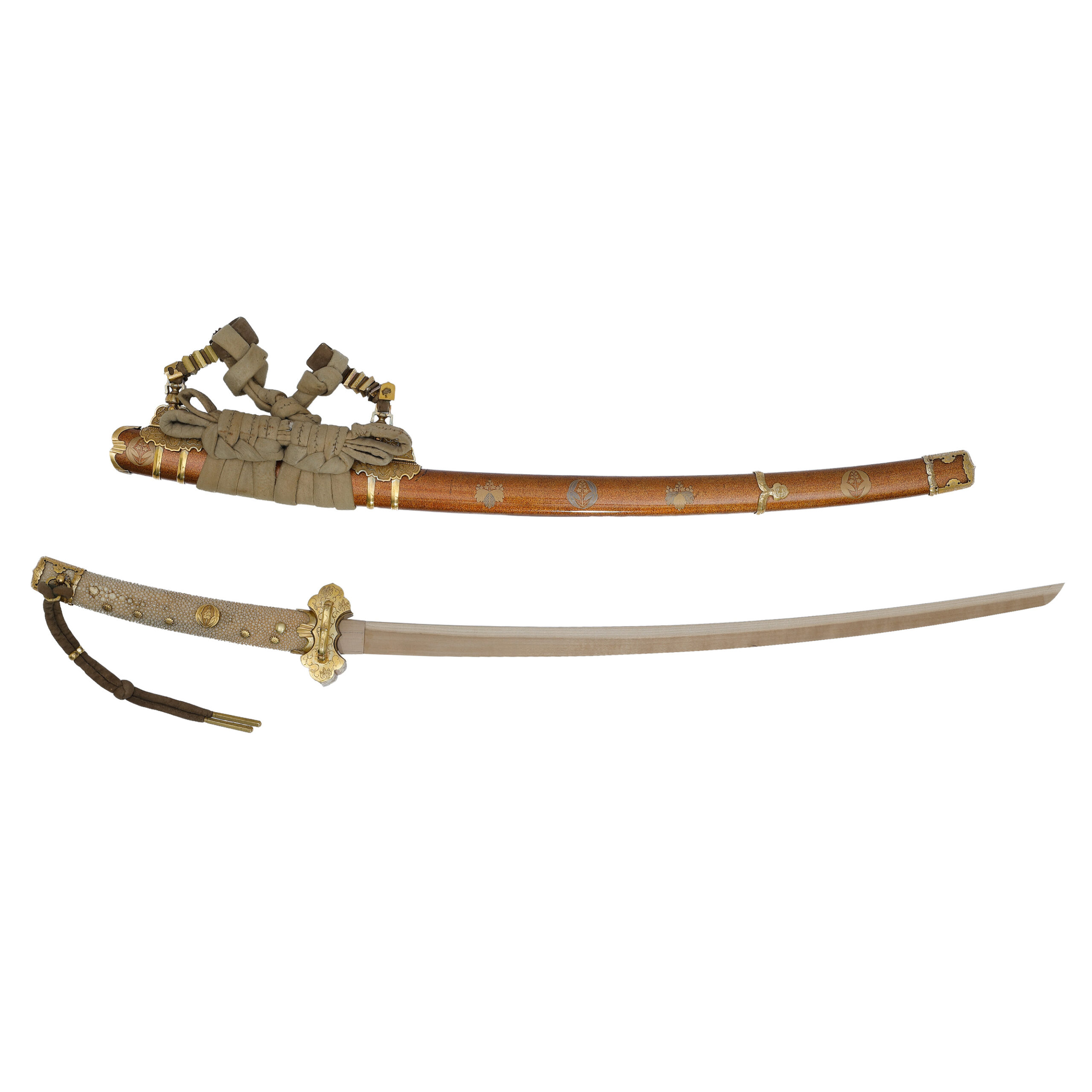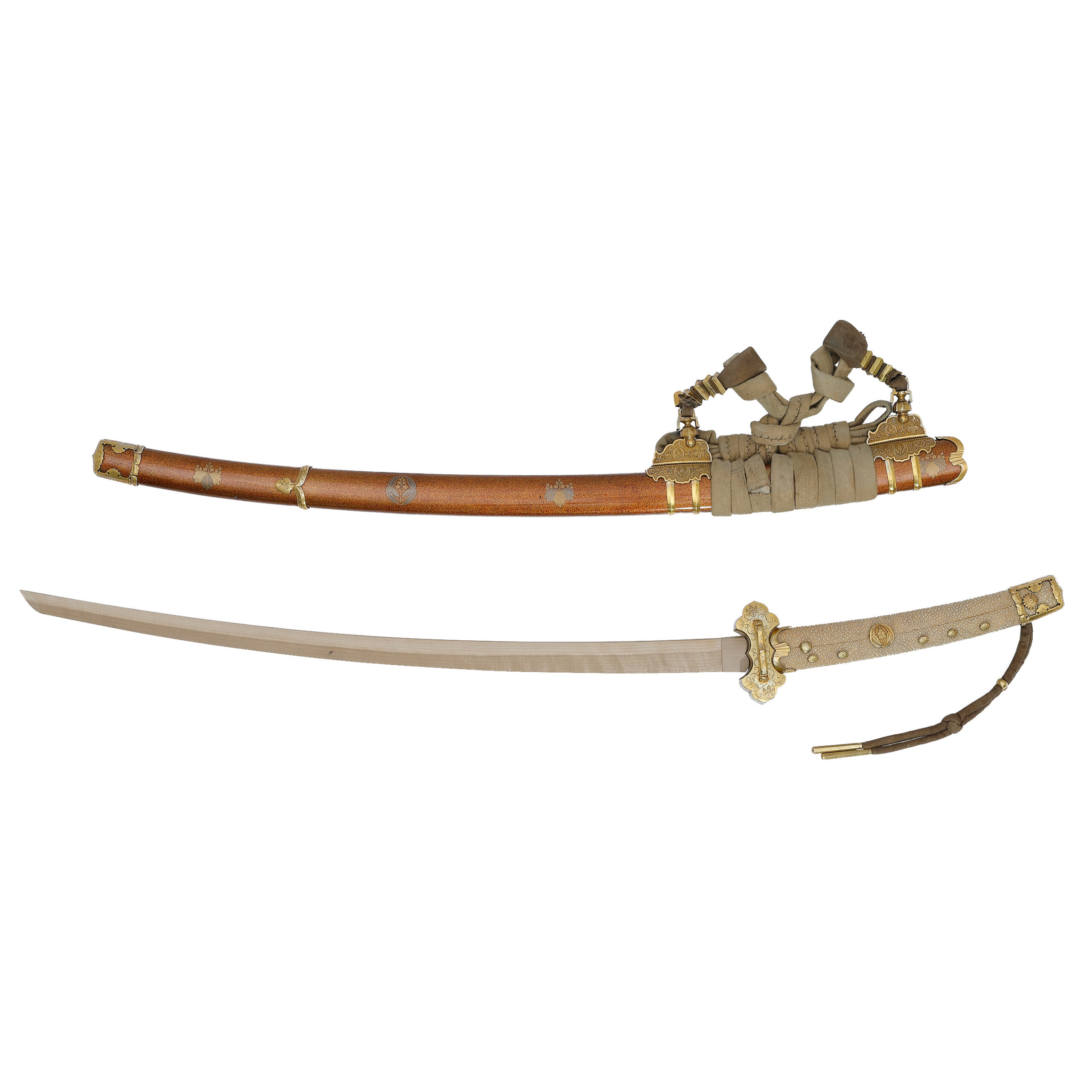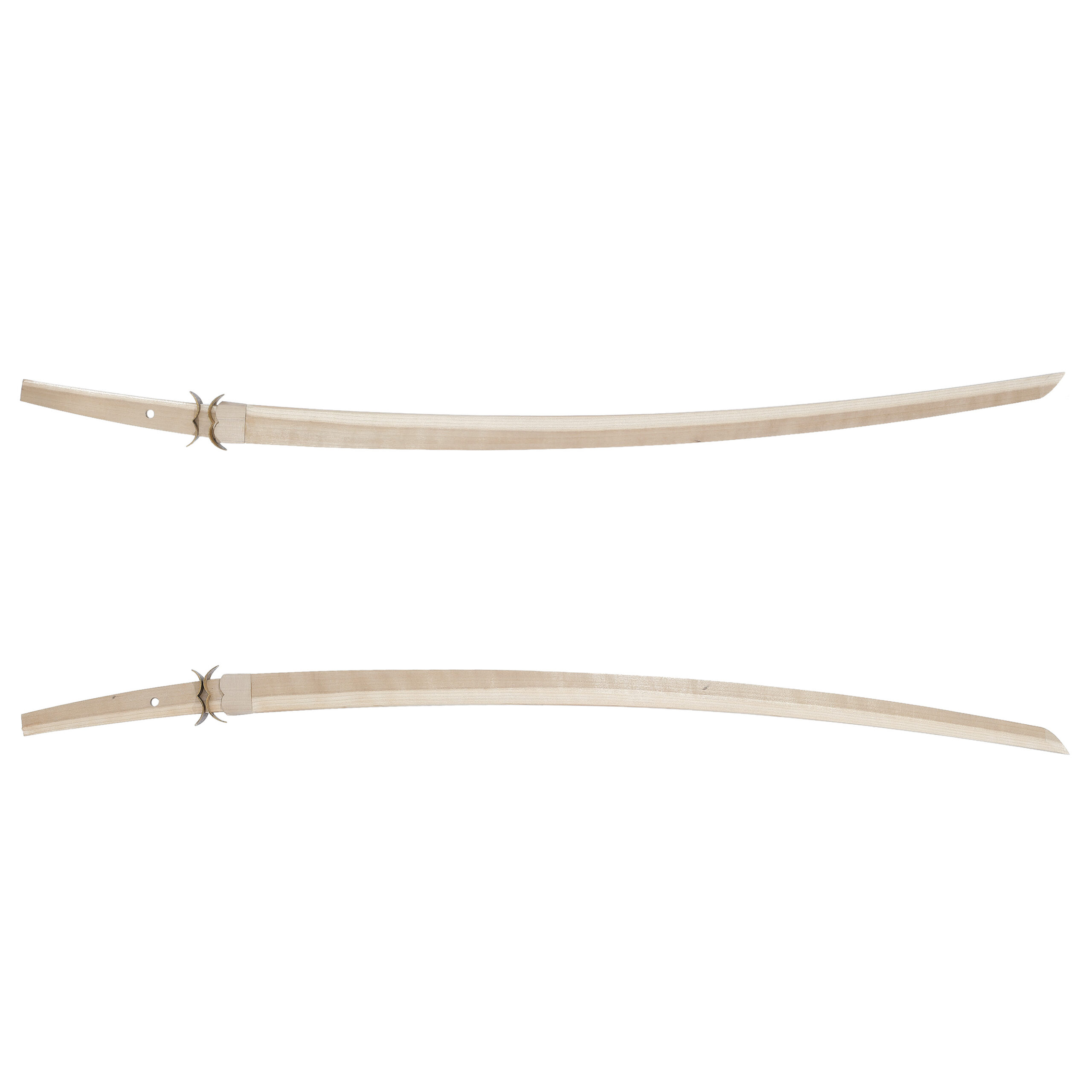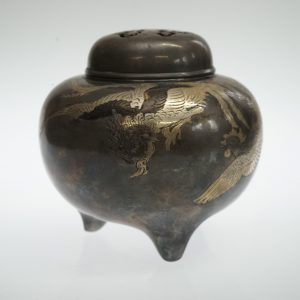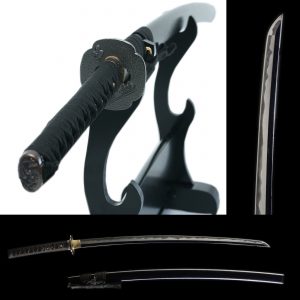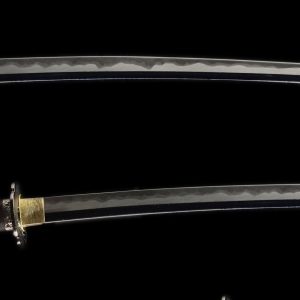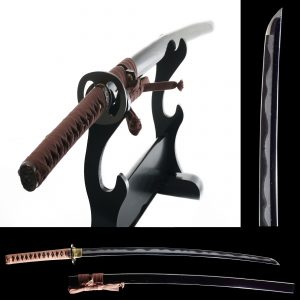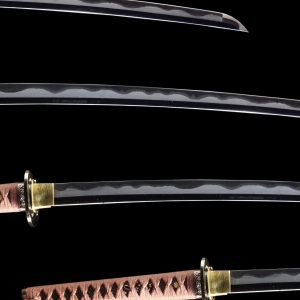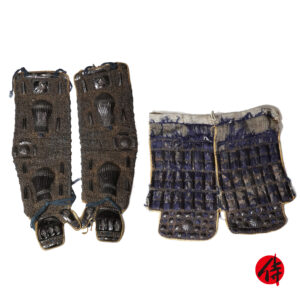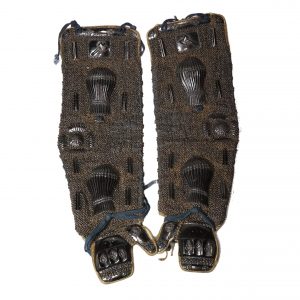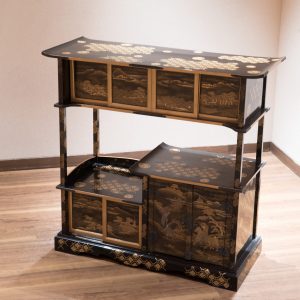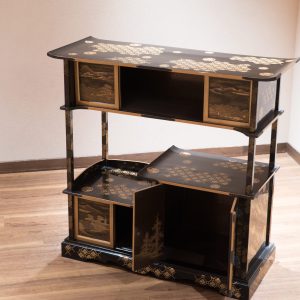Tachi Koshirae for Samurai Sword NO BLADE INCLUDED with Tokubetsu Kicho Kodogu (Koshirae-12)
【Overall】


【Handguard】
This gorgeous golden Tsuba is categorized as the Kara Tsuba (唐鐔). This type of Tsuba was initially used for the Kara Tachi (唐太刀)-style Koshirae. The continental style changed to the Japanese style during the Heian period (794-1185), and it came to be applied to decorative swords for ceremonial purposes. The Kara Tsuba was also called the Hundou Tsuba (分銅鐔) because its shape was similar to the Goto Hundou (後藤分銅, a type of weight) used in the Edo period.
The family crest is depicted on this Tsuba. This crest is called the Gosan-no-Kiri Mon (五三の桐紋). The Kiri (桐, paulownia) pattern generally comprises three standing straight inflorescences and three leaves. The number of blooming flowers at each inflorescence means the ranks of this design. The Gosan-no-Kiri (五三の桐) pattern is a popular design that the paulownia motif is used. According to tradition, the Houou (鳳凰, Fenghuang) rests its wings at the paulownia tree; therefore, it has come to be regarded as a holy plant. Cherry blossom is one of the seasonal things of spring, and Japanese people have appreciated this plant for a long time. A theory says that the god of grain exists in cherry blossoms. Therefore, this flower pattern has been treated as the symbol of a plentiful harvest. The Karakusa pattern is a design in which vine stems and leaves are twined and make curves. Since ivy has a strong vitality and grows without interruption, people regarded this design as a symbol of prosperity and longevity.
Also, the Karakusa (唐草, arabesque) pattern is also designed. It is a pattern in which stems and leaves of vines are twined and make curves. Since ivy has a strong vitality and grows up without interruption, people regarded this design as a symbol of prosperity and longevity. Vine is called Tsuru (蔓) in Japanese, and it has another pronunciation; “Man.” There is a word 万 (it is also read Man), which means ten thousand. In the Karakusa pattern, leaves and vines are connected like Obi (帯, belt). The word “帯” can also be read “Tai.” Due to its pronunciation, the term “代 (Tai)” is associated. From this word-association game, an idiom 万代 is associated, and it means a thousand generations. In other words, we could imagine that people used this design wishing prosperity and longevity for their clans for a long time.
As with other metal fittings, the gold color gives an elegant impression.
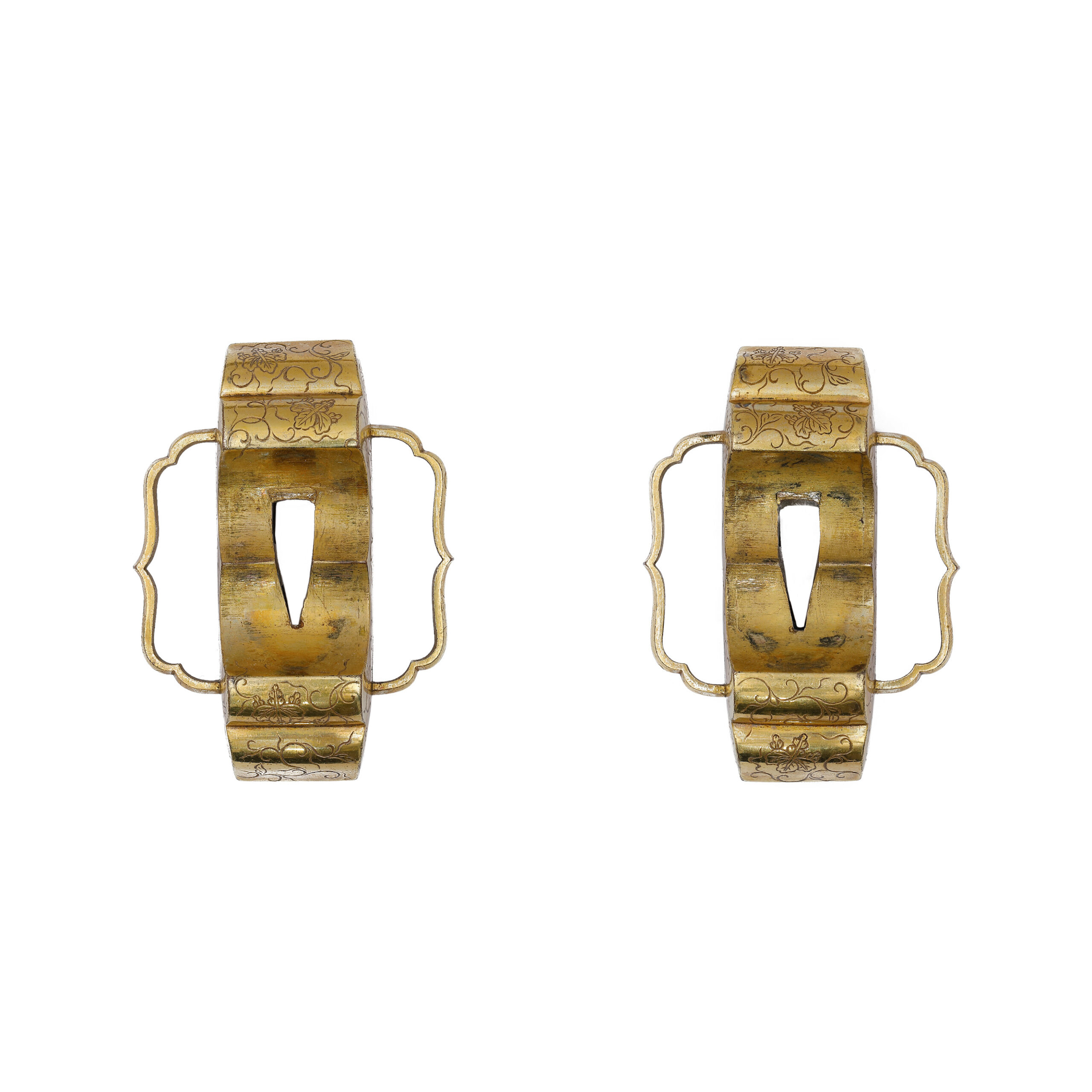
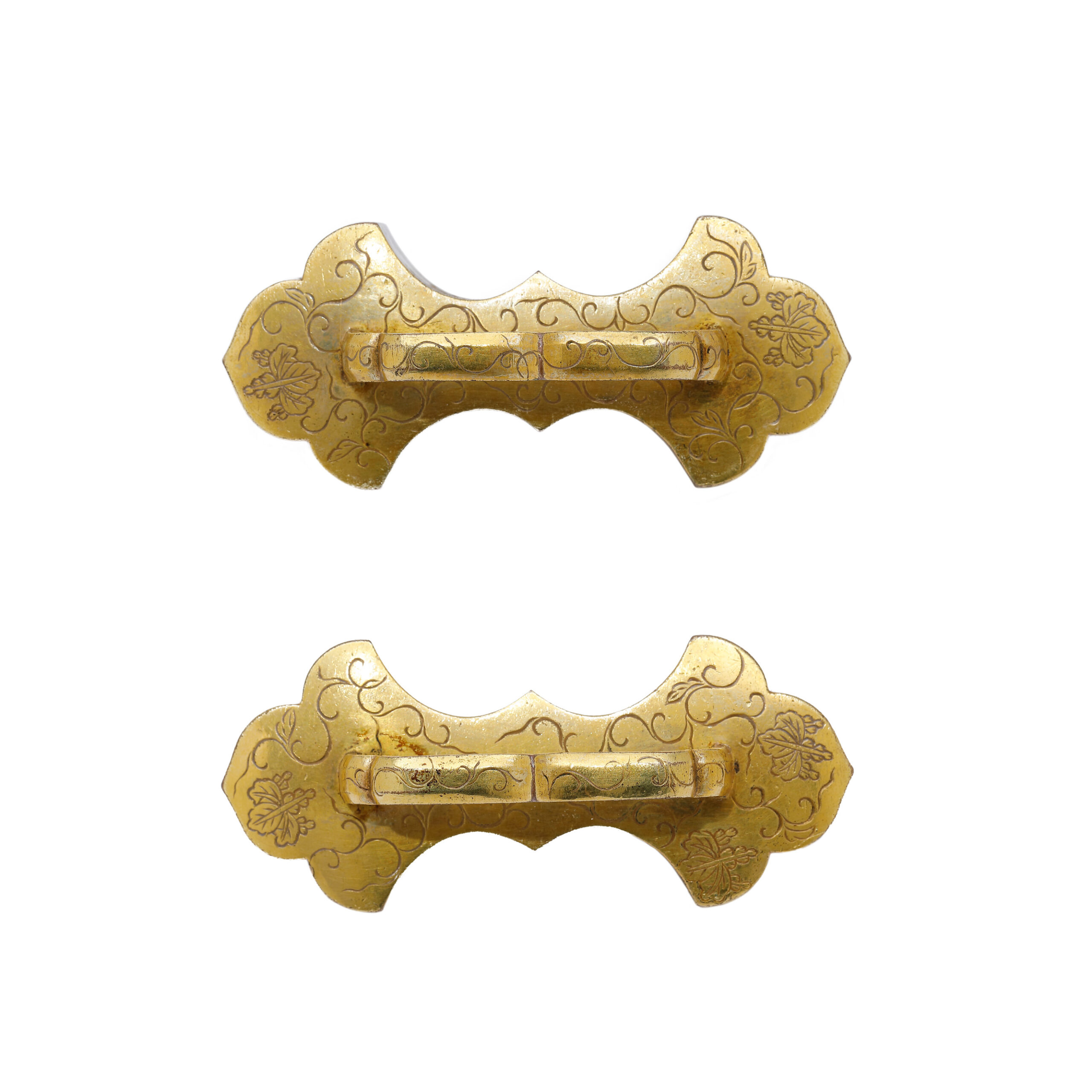
【Scabbard】
The Nashiji Nuri (梨子地塗) technique decorates this scabbard. It is a kind of Makie (蒔絵) method. This surface treatment method creates a rough texture by creating fine unevenness on the surface of the metal. They also come in varying degrees of gloss, including glossy, semi-gloss, and matte. According to a theory, it was invented in the Kamakura (鎌倉) period (1185-1333), and in the Edo period, various techniques were devised to color the products.
Regarding the design of this scabbard, in addition to the Gosan-no-Kiri Mon (五三の桐紋), there is a plant crest design. This design is called the Daki Omodaka (抱き沢瀉) pattern, which is a type of Omodaka (沢瀉, threeleaf arrowhead) pattern. The Omodaka is a plant, and Daki means embracing. The Daki Omodaka pattern consists of two Omodaka leaves embraced from both sides, with a single inflorescence with two flowers in the center. The name Omodaka was compared to another ward Omodaka (面高), which means save face/ keep honor. Also, as its leaf looks similar to an arrowhead (the arrow was once the primary weapon for Samurais), this plant was called the Kachi-Gusa (勝ち草, winning leaf). Based on these things, the Omodaka motif was appreciated among Samurais, and they used it for their family crests.
The Seme Kanamono (責金物, a metal fitting attached to the middle of the scabbard to protect the scabbard), the Ishiduki Kanamono (石突金物, a metal fitting attached to the end of the scabbard), Ashi Kanamono (足金物, metal fittings attached to the positions where Sageo cord is wrapped), Yamagata Kanamono (山形金物, the mountain shaped parts of the Ashi Kanamono), these metal parts are also decorated with the Gosan-no-Kiri (五三の桐), Daki Omodaka (抱き沢瀉), and Karakusa (唐草) pattern.
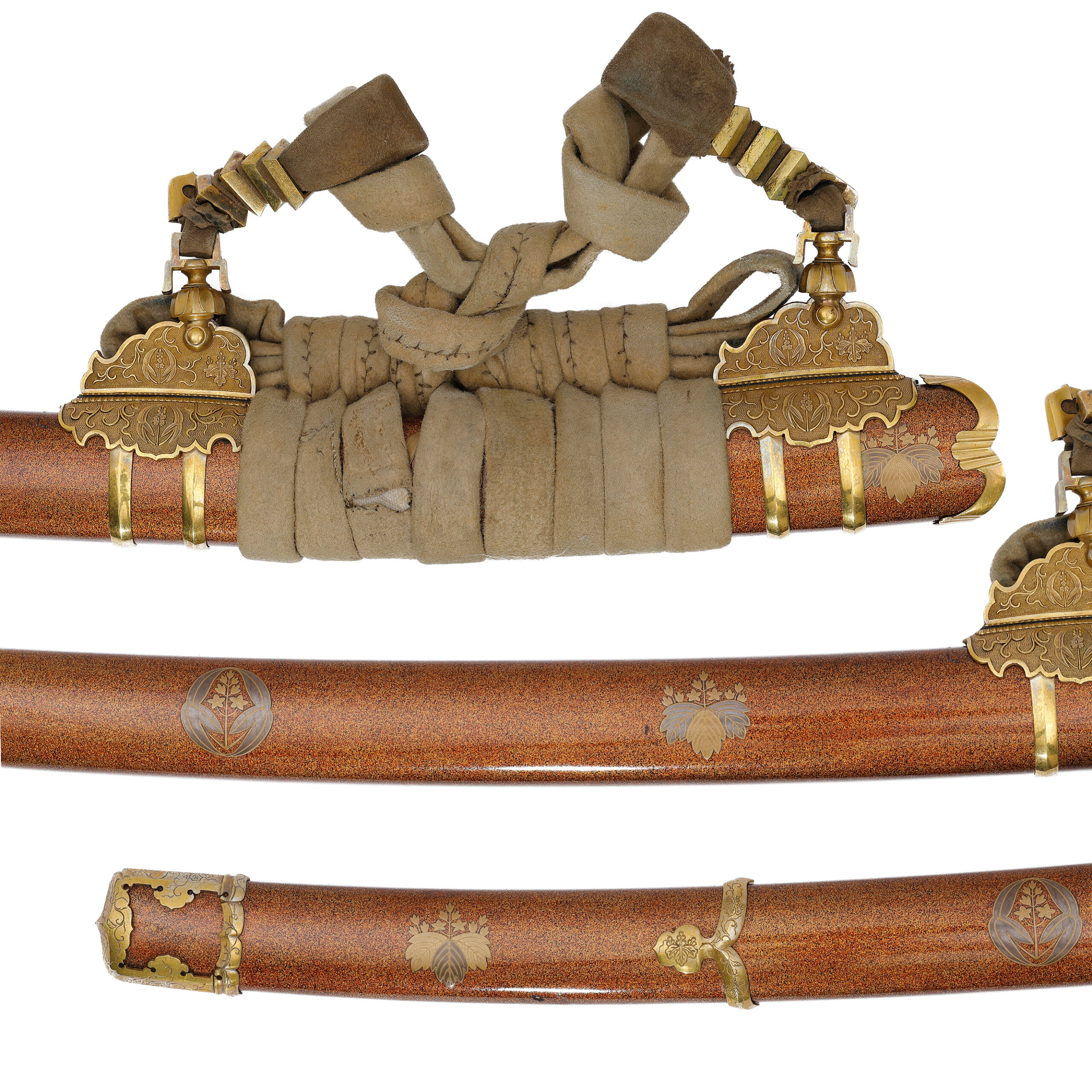
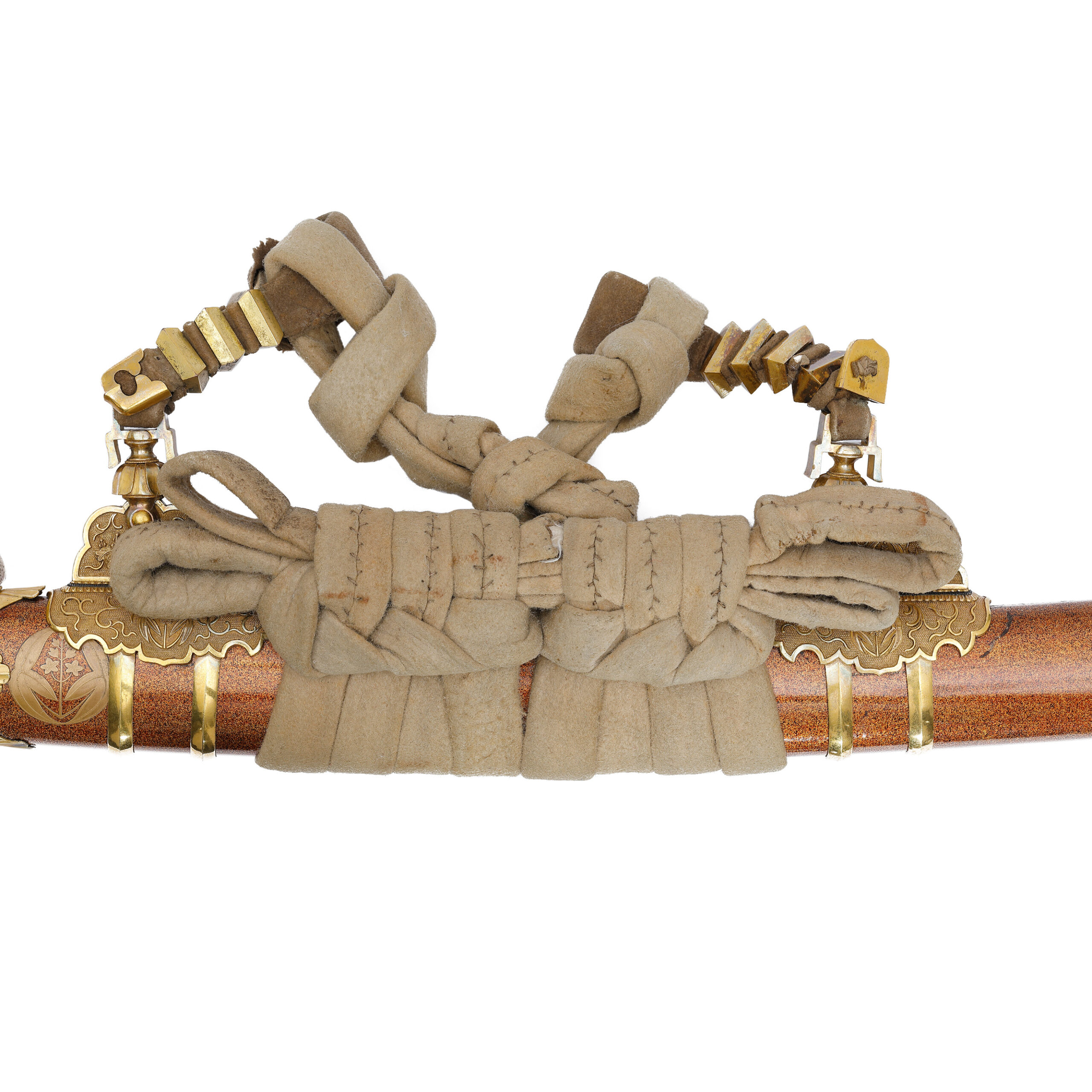

【Handle】
The handle is covered with the stingray skin. You would find chrysanthemum (菊, Kiku) crests are placed at equal intervals on the handle. A long time ago, the chrysanthemum was used as a medicine for obtaining a long life in China, and it was brought to Japan with this thought in the Nara period (648-781). Chrysanthemum is one of the flowers which symbolizes fall, and people appreciate it very much since ancient times. As its petals form radially, the chrysanthemum has been likened to the sun. That is why this flower pattern is treated as the symbol of perpetual youth and longevity or good health. “Kiku no Gomon (菊の御紋)” is a kind of chrysanthemum pattern, and it has been used as the crest of the Emperor and the royal family in Japan so that it is well-known as a noble pattern.
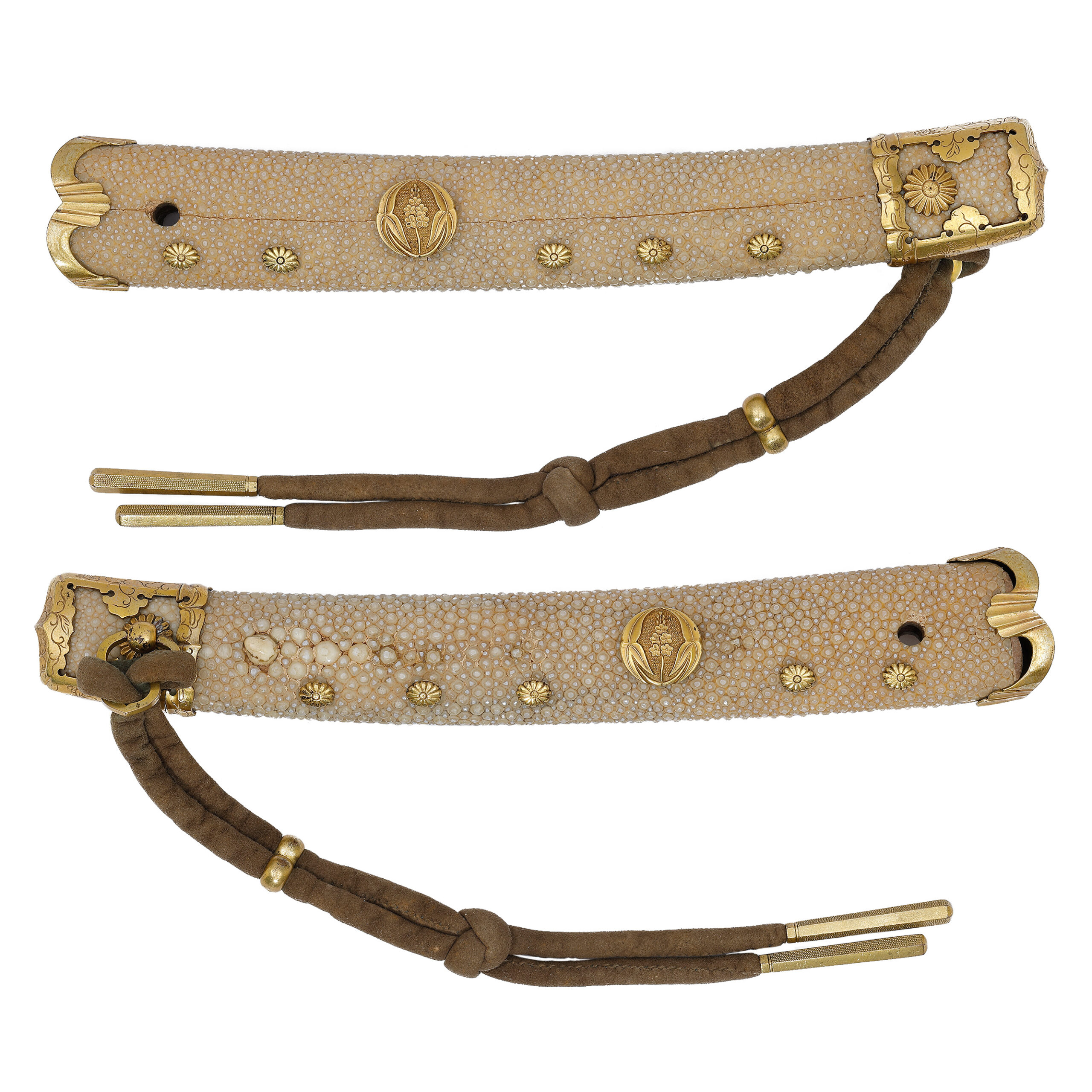
【Pommel】
A metal fitting called the Kabutogane (冑金/兜金) is attached to the end of a handle. Also, the Sarute/Sarude (猿手) is attached to this Kabutogane. The user of a sword passed the Udenukio (腕貫緒, a cord wrapped around the wrist to prevent a sword from falling out of the hand, mainly used when riding a horse) through this ring. These metal parts are decorated with the Gosan-no-Kiri (五三の桐) and Karakusa (唐草) pattern. Also, the chrysanthemum crest is placed in the gap of the Kabutogane. The Fuchi Kanamono (縁金物) is also attached to the opposite side of Kabutogane on the handle.

【Hilt Decor】
The Daki Omodaka crest is used here, the same as other metal fittings. We could also feel the consistent commitment of the client here.
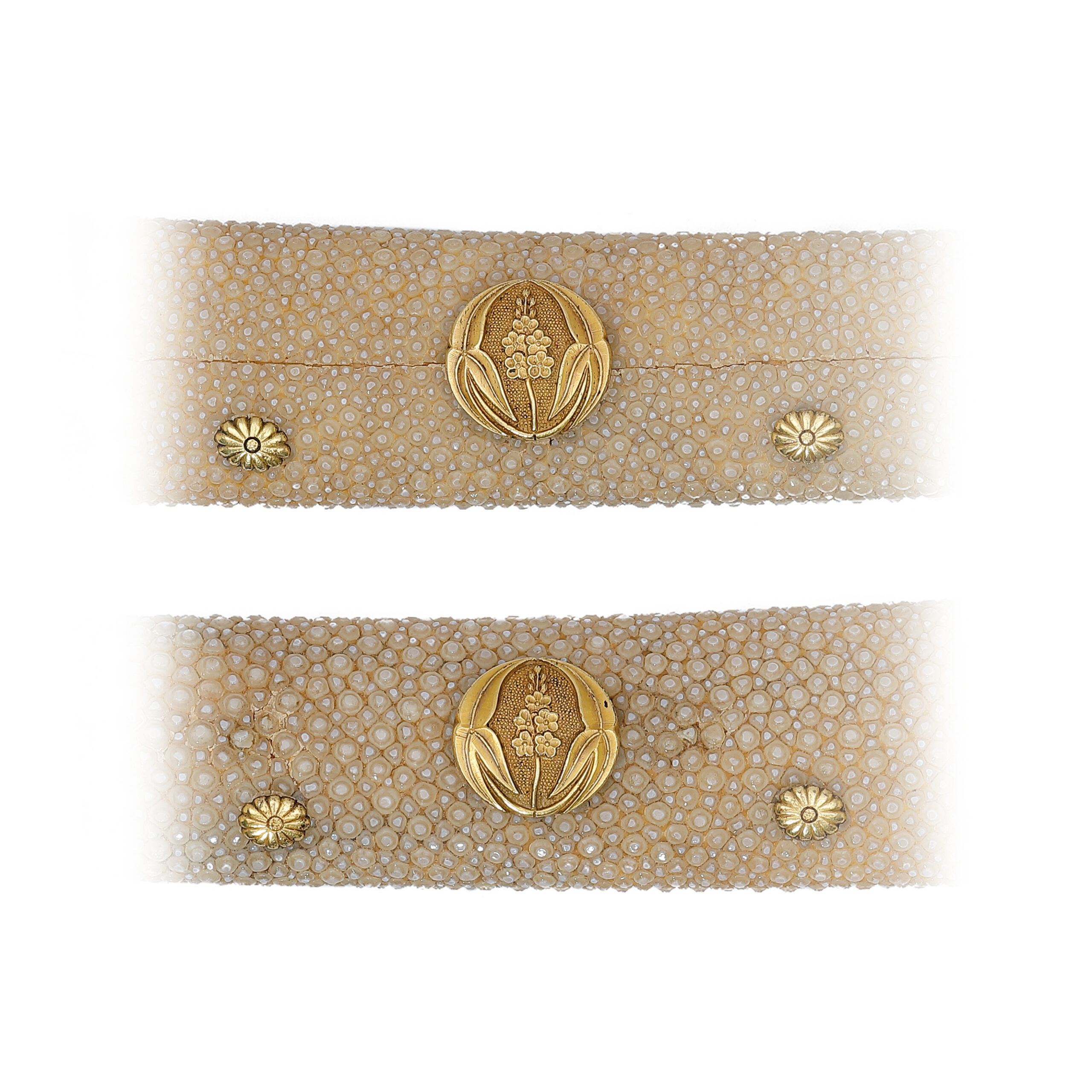
Authentication Paper: NBTHK TOKUBETSU Kichou Certificate for the Koshirae
NBTHK, also known as Nihon Bijutsu Touken Hozon Kyokai (the Society for the Preservation of the Japan Art Sword), is one of the oldest Japanese sword appraising organizations in modern-day Japan. They authenticated the Koshirae on November 25th in the 32nd year of Showa (1957). They appraised it as Tokubetsu Kichou Kodougu, an old form of the certificate. The purchaser will receive this original certificate as well. We can also translate what is written into English and make a PDF file for your record if you request.
*Please note that there is a section that has been clipped, but this is where the previous holder’s name was originally written, and it had already been clipped when we received this appraisal.

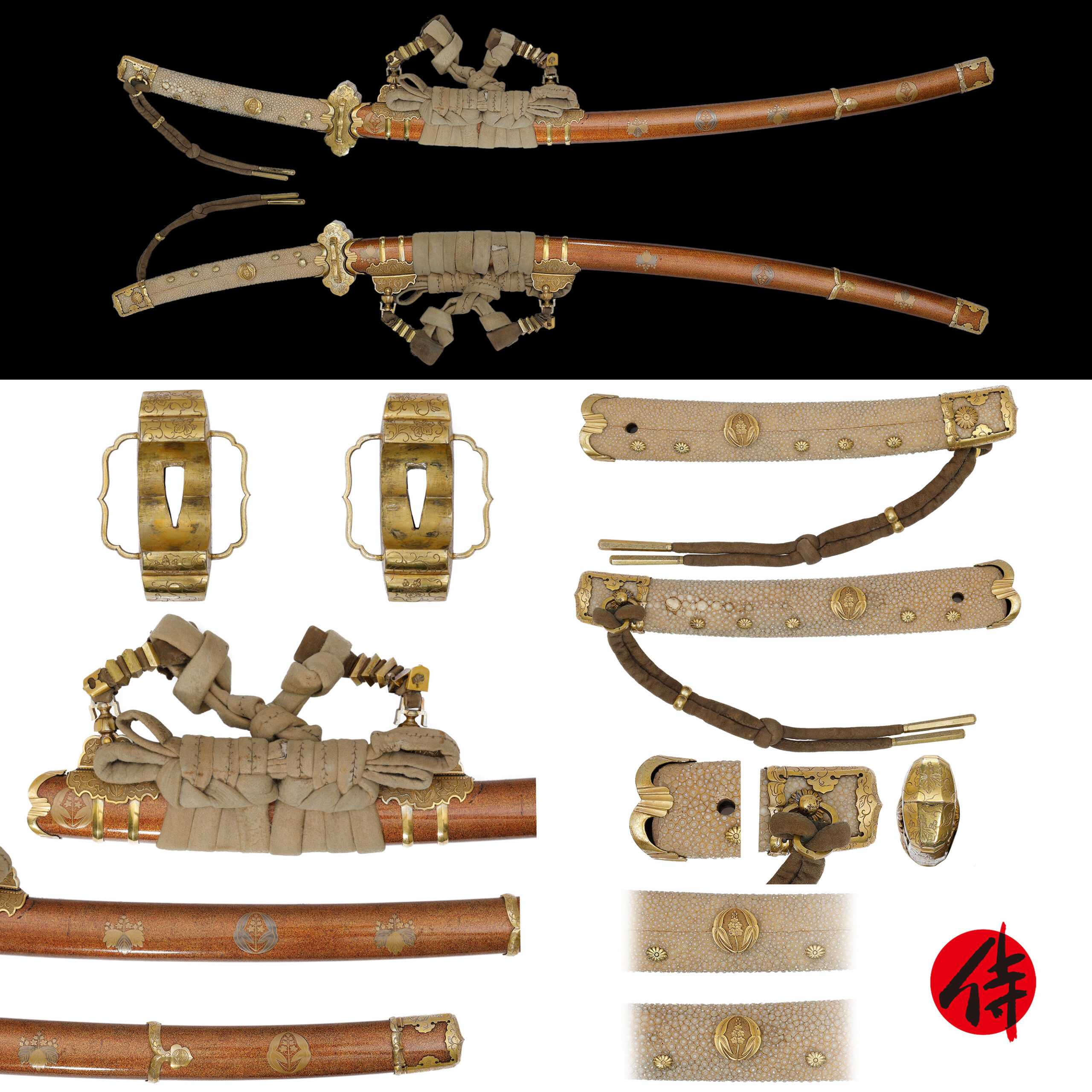
—————————————————————————————————-
【About us】
Samurai Museum is located in Tokyo, Japan, exhibiting antique artifacts related to the Samurai history. Samurai Museum Shop is the place for those who are interested in Japanese culture and craftsmanship. We deal with antique Samurai swords/armor, traditional crafts made in Japan and so on.
【Payment method】
We accept payment through Stripe (Credit card), PayPal, Apple Pay or ChromePay, all of which are secure payment methods. Also, you don’t need to make an account on Stripe for the checkout. If you prefer other payment method, please contact us. You may either pay in JPY, USD, AUD, CAD, EUR, CHF or GBP. The price is set in Japanese Yen. Prices in other currencies are automatically calculated based on the latest exchange rate.

【Shipping duration】
We normally ship via EMS (Express Mail Service) provided by Japan Post. It usually takes at least 5-14 days to deliver the package after you place an order. Time of delivery is estimated as accurately as possible by the carrier but does not take into account any delays beyond our control such as by inclement weather, post office holiday seasons.
We offer Free International Shipping as long as we can ship your order by EMS. If you prefer other shipping carriers, please contact us.
We will inform you of the order’s tracking number via email. Please make sure you fill out your valid email address correctly.
*If you like to make sure if EMS shipping is available to your country, please contact us.

【Antique Japanese item and Export process】
After receiving the full payment from you, we will apply for its export permit from the Board of Education to legally export the item to other countries. It normally takes around 2 to 4 weeks to receive this permit. And we would like you to expect at least 1.0 – 1.5 months for your order to arrive at your given address after you ordered.
【How to make sure the condition】
Please keep in mind that what you are going to purchase is an antique item. We uploaded high resolution photos for you to check its condition thoroughly. If you like to see more photos with different angles, please feel free to contact us. We will be happy to send them to you so that you can make informed decision.
It is essential for us to know that you are happy with your choice of antique item and we are prepared to use the best of our ability to serve you.
Would you like see some more Antique items for sale? Please check the link below. We hope you can find your favorite item.
https://www.samuraimuseum.jp/shop/product-category/antique/
